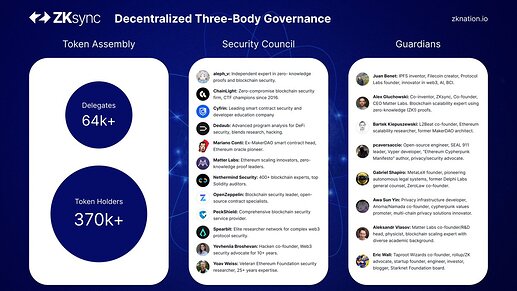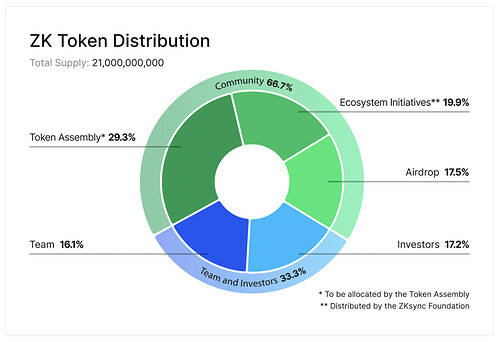Hey there @rahul-kothari - thanks for the questions! I hope these answers are helpful:
What is the ZKsync Association? What does membership of the ZKsync Association look like?
The ZKsync Association is an association under the laws of Austria, with its corporate seat in Vienna (“Association”). The Association is a voluntary, permanent establishment for the pursuit of the direct and indirect promotion, development, and support of the ZKsync blockchain protocol, the surrounding community, and its ecosystem.
Prior to submitting a proposal or voting through the canonical governance portal, every Delegate can opt in to join the ZKsync Association. This is a new model to address potential personal legal liability of Delegates for decisions made in connection with the Token Assembly (i.e. token holders who delegate their voting power and Delegates who receive this voting power).
You can read more about ZKsync Association Membership here.
What is the ZK Nation?
ZK Nation includes individuals, organizations, and technologies that bring the vision of the ZK Credo to reality, expanding freedom and accelerating intentional innovation.
ZK Nation encompasses all of the different stakeholders in the ZKsync community - including ZKsync devs & users, ZKsync advocates, token holders & Delegates (Token Assembly), ZKsync Foundation, ZKsync Association, the Security Council, and Guardians.
You can read more about ZK Nation here.
What is the Token Assembly?
The Token Assembly includes token holders who delegate their voting power and are represented by the Delegates who receive this voting power. A token holder can also choose to be their own Delegate and vote directly. The Token Assembly proposes, deliberates and approves initiatives that govern the ZKsync protocol, the ZK token, and the ZKsync governance system, fostering a collaborative decision-making process.
You can read more about the Token Assembly and other governance bodies here.
Can Token Assembly Delegates submit proposals?
Yes. To submit a proposal, Delegates must meet the proposal submission threshold of 0.1% or 21 million ZK of the total ZK token supply (21 billion). If a Delegate does not meet the threshold, or the author is not a Delegate, they can find a Delegate to sponsor and submit the proposal on their behalf. Delegate profiles can be viewed at delegate.zknation.io.
You can read more about ZKsync Proposal Guidelines here.
Who are the Guardians?
Take a look at this blog post that was published last Thursday to get a full overview of the Guardians and their profiles. This list is also included on the Schedule 4: ZKsync Guardians page at docs.zknation.io.
Who are the members of the Security Council?
Take a look at this blog post that was also published last Thursday that outlines the Security Council and its members. This list is also included on the Schedule 3: ZKsync Security Council page at docs.zknation.io.
Full overview of governance bodies:
What tokens can be accessed by the Token Assembly?
The Token Assembly has been allocated 29.3% of the total supply of ZK tokens. This is not held in a treasury. Instead, it is accessed by minting tokens from the ZK token contract. For most onchain organizations, tokens are minted at launch and passively held in wallets/in a treasury. ZKsync uses capped minters. Instead of minting the entire supply of tokens at once, capped minters have “just-in-time minting.” This design allows new interaction models, such as connecting smart contracts that burn and mint ZK tokens autonomously.
You can find more information on the initial token distribution on the ZK Token page of docs.zknation.io.
The Token Governor is responsible for executing
Token Program Proposals (“TPPs”) that assign minting and burning rights of ZK tokens for token programs that are aligned with the Token Program Guidelines, and help achieve the goals supporting the vision of the ZK Credo. The Token Governor is governed by the Token Assembly (i.e. token holders & Delegates).
The Guardians may exercise an onchain veto on any proposal submitted to the Token Governor or the GovOps Governor (“Onchain Veto”). With the signatures of five (5) Signers on the Guardian Multisig, the Guardians have the power to execute an Onchain Veto by calling the cancel function from the Guardian Multisig, which means the proposal cannot progress towards execution.
What is the ZKsync Foundation?
The ZKsync Foundation is a Cayman foundation that, among other things, provides grants and enters into agreements with a diverse range of (potentially competing) market participants each of whom are working on or in relation to ZKsync, ZKsync related technology, the Ethereum ‘layer-1’ blockchain system or other zero-knowledge based cryptographic technology more widely, including for the purposes of studying, evaluating, testing, monitoring, maintaining, facilitating, fostering and improving the use or functionality of ZKsync and ZKsync related technology.
The ZKsync Foundation is allocated a ZK capped minter with 19.90% of the total supply of ZK tokens. The ZKsync Foundation administers grants, incentives, and other ecosystem initiatives, supports emergency responses, and can submit (but not approve) Token Program Proposals without a Delegate sponsor with the necessary 21M voting power.
You can find more information on the initial token distribution on the ZK Token page of docs.zknation.io.
If there are any further questions, or if anything is still unclear regarding the above, feel free to drop in this thread! 

